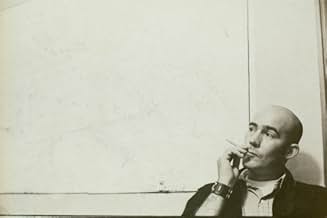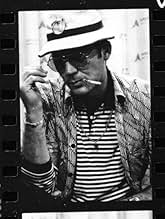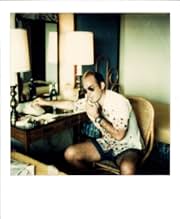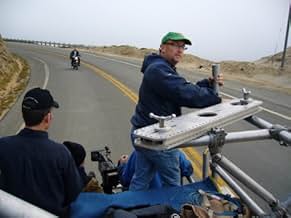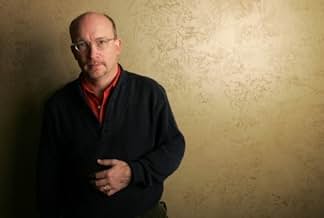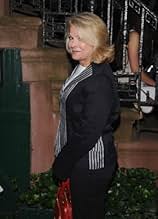AVALIAÇÃO DA IMDb
7,6/10
8,7 mil
SUA AVALIAÇÃO
Adicionar um enredo no seu idiomaA portrait of the late gonzo journalist Hunter S. Thompson.A portrait of the late gonzo journalist Hunter S. Thompson.A portrait of the late gonzo journalist Hunter S. Thompson.
- Direção
- Roteiristas
- Artistas
- Prêmios
- 1 vitória e 5 indicações no total
Hunter S. Thompson
- Self
- (cenas de arquivo)
Oscar Acosta
- Self
- (cenas de arquivo)
Muhammad Ali
- Self
- (cenas de arquivo)
Warren Beatty
- Self
- (cenas de arquivo)
- Direção
- Roteiristas
- Elenco e equipe completos
- Produção, bilheteria e muito mais no IMDbPro
Avaliações em destaque
After Enron: The Smartest Guys in the Room, Taxi to the Dark Side, and this vivid, significant depiction of the Sixties and Seventies superstar journalist Hunter Thompson, Alex Gibney has emerged as clearly one of the best documentary filmmakers we've got and also one of the most prolific.
Gibney tells a very smart, very verbal, very funny but also intensely significant story here. Some of the people who speak most highly of Thompson on camera are Billy Carter, William McGovern, and longtime Republican presidential adviser Pat Buchanan,as well as writer Tom Woolf and Thompson's editors at Rolling Stone, for which he did his best periodical pieces, the notable ones turned into books. More intimate details--but the man was such a perpetual performer that public and private are hard to separate--come from Thompson's first and second wives. And the English artist Ralph Steadman, who illustrated the writing, has much to say, as do plenty of others. When Steadman first met Thompson he fed the Brit Psilocybin and he was never the same. Steadman became an invaluable cohort and collaborator and his wild drawings provide a perfect visual counterpart to Thompson's written words on screen.
Thompson was a notorious wild man from early on. "I wouldn't recommend sex, drugs or insanity for everyone, but they've always worked for me," he said. Prodigious in his consumption of drugs and alcohol, he was witness to some of the great events of his time, and got deeply involved in politics and opposition to the Vietnam war and of course the counterculture. Lean, athletic, flashily dressed, with trademark balding pate, big sunglasses, cigarette holder and drink in hand, Thompson was a demon at the IBM Selectric, gleefully spinning out brilliant pieces nobody else could have written, a master of outrage and wit.
Fueled by craziness, substances, and his own tongue-in-cheek joie de vivre, he devised his own outrageous style of writing in which cold clear fact was blended with wild invention and the adjectives and metaphors flew like hornets around a honey pot. Others too partook of the kind of journalism he practiced. The times--the flamboyant and boisterous and revolutionary Sixties and early Seventies-- seemed to call for a new more violent, more committed language in journalism. Norman Mailer also wrote about the democratic convention in Chicago in 1968 and on hand for Esquire were the likes of Jean Genet and William Burroughs. Three is something of Burroughs in Thompson, the drugs and the outrage and a way of seeing convention as conspiracy. One of Thompson's famous quotes gives a hint of the link: "America... just a nation of two hundred million used car salesmen with all the money we need to buy guns and no qualms about killing anybody else in the world who tries to make us uncomfortable." This was the moment when the distinction between fiction and non-fiction blurred: Tom Wolfe (The Electric Kool-Aid Acid Test, which used raw material from the more adventurous Thompson), Thompson's act of "embedded journalism" as Wolfe calls it, Hell's Angels), Truman Capote's murder story In Cold Blood done for The New Yorker, were all variations on the idea of the "non-fiction novel." Mailer had done a heroically personal and novelistic account of the 1967 March on the Pentagon, The Armies of the Night. The film might do a bit more to put Thompson in all this context, but it's clearly implied. He called his wild style "gonzo" journalism.
Thompson also wrote about Las Vegas as the American dream and about Nixon, whom he loathed. He also used a tape recorder a lot. This provides great material for the film. So does the Terry Gilliam film version of Fear and Loathing in Las Vegas; and Johnny Depp, who played Thompson in the film and became a great fan and friend, reads salient passages sitting in front of a well-stocked bar. Depp paid for the spectacular monument/funeral for the writer that Thompson had--on film--planned out long before, in which his ashes are fired into the Colorado hills. Ralph Steadman did the sketches. This is shown at the end of the film and provides a lovely son et lumière finale.
Thompson's innate violence may explain how he could have blended in so well for a while with the Hell's Angels. He kept at least twenty firearms on hand in his house, all loaded, his first wife reports. He always planned to end his life with suicide and he shot himself. He did it on a nice day in February almost as a family event, with his son, daughter-in-law and grandson at the house and on the phone with his wife, a shot to the head, at the age of 68, not an act of depression but the completion of a careful plan. It was over. And he had been here to see George W. Bush and predict the decline and fall of the American empire. A late collection of short pieces is entitled Hey Rube: Blood Sport, the Bush Doctrine, and the Downward Spiral of Dumbness.
His dissipation took its toll and so did fame. He fell into playing a self-parodying avatar of himself and his writing deteriorated after the later Seventies, so he had about ten good years and about twenty not-so-good ones. Some have dwelt on his decline; Gonzo doesn't. His writing faltered as early as 1974 when he went to Zaire with Steadman to cover the Foreman-Ali "Rumble in the Jungle" and he got drunk at the pool during the fight and never finished the story. Given how bright he burned and how hard he lived, it was inevitable that the man would burn out early And writing did not by any means fizzle out even into the Nineties. There is an immense wealth of spinoffs on film; Gibney had rich, rich material to work with here.
The best that could happen is that this beautifully edited and greatly entertaining film makes a host of new converts to the writing.
Gibney tells a very smart, very verbal, very funny but also intensely significant story here. Some of the people who speak most highly of Thompson on camera are Billy Carter, William McGovern, and longtime Republican presidential adviser Pat Buchanan,as well as writer Tom Woolf and Thompson's editors at Rolling Stone, for which he did his best periodical pieces, the notable ones turned into books. More intimate details--but the man was such a perpetual performer that public and private are hard to separate--come from Thompson's first and second wives. And the English artist Ralph Steadman, who illustrated the writing, has much to say, as do plenty of others. When Steadman first met Thompson he fed the Brit Psilocybin and he was never the same. Steadman became an invaluable cohort and collaborator and his wild drawings provide a perfect visual counterpart to Thompson's written words on screen.
Thompson was a notorious wild man from early on. "I wouldn't recommend sex, drugs or insanity for everyone, but they've always worked for me," he said. Prodigious in his consumption of drugs and alcohol, he was witness to some of the great events of his time, and got deeply involved in politics and opposition to the Vietnam war and of course the counterculture. Lean, athletic, flashily dressed, with trademark balding pate, big sunglasses, cigarette holder and drink in hand, Thompson was a demon at the IBM Selectric, gleefully spinning out brilliant pieces nobody else could have written, a master of outrage and wit.
Fueled by craziness, substances, and his own tongue-in-cheek joie de vivre, he devised his own outrageous style of writing in which cold clear fact was blended with wild invention and the adjectives and metaphors flew like hornets around a honey pot. Others too partook of the kind of journalism he practiced. The times--the flamboyant and boisterous and revolutionary Sixties and early Seventies-- seemed to call for a new more violent, more committed language in journalism. Norman Mailer also wrote about the democratic convention in Chicago in 1968 and on hand for Esquire were the likes of Jean Genet and William Burroughs. Three is something of Burroughs in Thompson, the drugs and the outrage and a way of seeing convention as conspiracy. One of Thompson's famous quotes gives a hint of the link: "America... just a nation of two hundred million used car salesmen with all the money we need to buy guns and no qualms about killing anybody else in the world who tries to make us uncomfortable." This was the moment when the distinction between fiction and non-fiction blurred: Tom Wolfe (The Electric Kool-Aid Acid Test, which used raw material from the more adventurous Thompson), Thompson's act of "embedded journalism" as Wolfe calls it, Hell's Angels), Truman Capote's murder story In Cold Blood done for The New Yorker, were all variations on the idea of the "non-fiction novel." Mailer had done a heroically personal and novelistic account of the 1967 March on the Pentagon, The Armies of the Night. The film might do a bit more to put Thompson in all this context, but it's clearly implied. He called his wild style "gonzo" journalism.
Thompson also wrote about Las Vegas as the American dream and about Nixon, whom he loathed. He also used a tape recorder a lot. This provides great material for the film. So does the Terry Gilliam film version of Fear and Loathing in Las Vegas; and Johnny Depp, who played Thompson in the film and became a great fan and friend, reads salient passages sitting in front of a well-stocked bar. Depp paid for the spectacular monument/funeral for the writer that Thompson had--on film--planned out long before, in which his ashes are fired into the Colorado hills. Ralph Steadman did the sketches. This is shown at the end of the film and provides a lovely son et lumière finale.
Thompson's innate violence may explain how he could have blended in so well for a while with the Hell's Angels. He kept at least twenty firearms on hand in his house, all loaded, his first wife reports. He always planned to end his life with suicide and he shot himself. He did it on a nice day in February almost as a family event, with his son, daughter-in-law and grandson at the house and on the phone with his wife, a shot to the head, at the age of 68, not an act of depression but the completion of a careful plan. It was over. And he had been here to see George W. Bush and predict the decline and fall of the American empire. A late collection of short pieces is entitled Hey Rube: Blood Sport, the Bush Doctrine, and the Downward Spiral of Dumbness.
His dissipation took its toll and so did fame. He fell into playing a self-parodying avatar of himself and his writing deteriorated after the later Seventies, so he had about ten good years and about twenty not-so-good ones. Some have dwelt on his decline; Gonzo doesn't. His writing faltered as early as 1974 when he went to Zaire with Steadman to cover the Foreman-Ali "Rumble in the Jungle" and he got drunk at the pool during the fight and never finished the story. Given how bright he burned and how hard he lived, it was inevitable that the man would burn out early And writing did not by any means fizzle out even into the Nineties. There is an immense wealth of spinoffs on film; Gibney had rich, rich material to work with here.
The best that could happen is that this beautifully edited and greatly entertaining film makes a host of new converts to the writing.
This is an absorbing doc not only of the good doc but the whole counterculture that he championed in many ways. For all his excessive lifestyle that became almost a parody of the drug culture, he remained a true intellectual and anti-corruption/hypocrisy crusader. He embraced the vision of a new world not ruled by greed and war-mongering, and as early as 1971 proclaimed his great sadness that the movement and the moment of flower power had passed and with it the chance for sane politics. This moment was captured well in "Where the Buffalo Roam" starring Bill Murray as HST, which is given kind of short shrift in this documentary in favor of scenes from "Fear and Loathing Las Vegas" with Johnny Depp as HST. Considering that Depp produced and narrates the film as well as financed the grandiose send-off that Thompson envisioned for himself, it's not strange that Murray's portrayal would be downplayed, as excellent as it was (and Peter Boyle's as the Samoan lawyer.)
All in all, it is a well-balanced account of Thompson's life and work, with many pertinent interviewees like his two wives and son, Jann Wenner of Rolling Stone, Sonny Barger of the Hell's Angels, Jimmy Buffett, George McGovern, Jimmy Carter, Pat Buchanan, Tom Wolfe, and various Aspenites. His passion and wit were undeniable, and his addiction to guns, booze and dope were in many ways forgivable. But his absence in today's disastrous political scene, his voice against war and corruption is sorely missed, and lamented by several of the interviewees. The parallels between Nixon and Bush are easily drawn, and "Gonzo" does this without hammering the point home except to exhort the audience to take up the fight that the Good Doctor waged in a seemingly crazy, but noble and honorable way for most of his life.
All in all, it is a well-balanced account of Thompson's life and work, with many pertinent interviewees like his two wives and son, Jann Wenner of Rolling Stone, Sonny Barger of the Hell's Angels, Jimmy Buffett, George McGovern, Jimmy Carter, Pat Buchanan, Tom Wolfe, and various Aspenites. His passion and wit were undeniable, and his addiction to guns, booze and dope were in many ways forgivable. But his absence in today's disastrous political scene, his voice against war and corruption is sorely missed, and lamented by several of the interviewees. The parallels between Nixon and Bush are easily drawn, and "Gonzo" does this without hammering the point home except to exhort the audience to take up the fight that the Good Doctor waged in a seemingly crazy, but noble and honorable way for most of his life.
Let's face it, either you loved or hated the life & words of the late Dr.Hunter S.Thompson,you have to admit...he was a piece of work. This documentary attempts to delve into the life (and head)of Thompson (not always with success,but don't let that throw you). The film (narrated by Johnny Depp,who played Thompson in 'Fear & Loathing In Las Vegas',some years back,making him a natural for the job)delves back to his association with the Hells Angels in the mid 1960's (which ended badly),to his being embraced by the whole Hippie counter culture of the later half of that era (along with massive intakes of various drugs),to writing several novels in the early to mid 1970's,to his subsequent downward spiral (in the creative sense),to his eventual death in 2005,by suicide (and his unorthodox memorial service). Hunter Thompson managed to make a name for himself. What I admired was the fact that it goes out of it's way to prove that the sixties was not always the hippie utopia that the baby boomer's make it out to be. What I could have done without was some of the more forgettable music from the 1960's & 1970's (does anybody really want to hear Jimmy Buffet's 'Margaritaville'for the twenty thousandth time?---I sure as hell don't). Apart from that, 'Gonzo:The Life & Work Of Dr.Hunter S. Thompson' will be a "must see" for those who tend to embrace the counter culture, rather than pop culture/trash culture.
In the sphere of all the memoirs collected in this post-counter culture portrait of a counter culture icon, narrated by Johnny Depp who played him to some extent in Terry Gilliam's film version of Fear and Loathing In Las Vegas, there was one issue I found noticeably absent: The reality of the unhappiness and suffering of this comic book character of a painfully vague crustacean. The film finds remarkable approach to the people involved in his life, but not even from his two wives do we get a picture of what he was like the inevitable physiological drawbacks caught up with him. He was plainly, intensely addicted to drugs and alcohol, and after a trance-like sleep not much different than passing out at the right time, he would have awakened in a mess of depression and alienation. What did he say on those mornings and afternoons? How did he act?
Of course, it is said during the film that he would drink all day or take drugs and there was no discernible effect. I don't think I buy that. What if it was a front? The main thing is, he wasn't killed by day-to-day simultaneous intakes of alcohol and pills, which can really tear up your head, which are said to cause a likelihood of seizures. He was killed by himself, which he himself scripted and all of his friends totally assumed would happen. He took every reckless risk there was to take, and he, not time or drugs or people, ended it all because his own agenda was dried out. As a journalist, for instance, he reported that at some point in a presidential primary Edward Muskie consumed Ibogaine, a psychoactive drug given out by a "mysterious Brazilian doctor," information which was entirely fictitious yet was actually learned and passed along as truth. Thompson's stunt may have been part of the cause of Muskie's furious irritability throughout the 1972 Florida primary. No other journalist could have carried such a fib, but Thompson was fortified by his myth that he could publish anything.
He was an unpredictable, nearly spellbinding writer, with a savage hilarity in his style. He was never aware of impartiality. In 1972 he backed George McGovern as the Democratic nominee, and no slander was too degraded for him to attach to McGovern's rivals in either party.
This documentary by Alex Gibney is notable, to begin with, for recapitulating to us through how many fires Thompson ran of his very own volition. He rode with the Hells' Angels for a year. Ran for sheriff and lost, but came in very close. Covered the 1972 and 1976 presidential primaries, and had an inexplicable personality, so that for instance McGovern, Tom Wolfe and his wives and son think of him lovingly, but also as enormously cruel and spiteful.
Nobody in the film was around while he was doing things that initially fortified him within the sphere of legend. He became celebrated for writing about that edge of speed going around a bend which you could never pass without killing yourself. He rode loads of edges on his motorcycle, and never got killed. He said persistently that the way he chose to go was by doing the job himself, with a gun, before his success declined. He died that way, using one of his 22 firearms, but he had most definitely declined by that time.
Without doubt he made an impact on his generation like not many other journalists ever have. This documentary is all you could wish for about the man's career and involvement with different people, but there is something at his core that we are inhibited from fully understanding for sure. And it results in you speculating on how so many people liked him when he didn't even seem to have liked himself?
Of course, it is said during the film that he would drink all day or take drugs and there was no discernible effect. I don't think I buy that. What if it was a front? The main thing is, he wasn't killed by day-to-day simultaneous intakes of alcohol and pills, which can really tear up your head, which are said to cause a likelihood of seizures. He was killed by himself, which he himself scripted and all of his friends totally assumed would happen. He took every reckless risk there was to take, and he, not time or drugs or people, ended it all because his own agenda was dried out. As a journalist, for instance, he reported that at some point in a presidential primary Edward Muskie consumed Ibogaine, a psychoactive drug given out by a "mysterious Brazilian doctor," information which was entirely fictitious yet was actually learned and passed along as truth. Thompson's stunt may have been part of the cause of Muskie's furious irritability throughout the 1972 Florida primary. No other journalist could have carried such a fib, but Thompson was fortified by his myth that he could publish anything.
He was an unpredictable, nearly spellbinding writer, with a savage hilarity in his style. He was never aware of impartiality. In 1972 he backed George McGovern as the Democratic nominee, and no slander was too degraded for him to attach to McGovern's rivals in either party.
This documentary by Alex Gibney is notable, to begin with, for recapitulating to us through how many fires Thompson ran of his very own volition. He rode with the Hells' Angels for a year. Ran for sheriff and lost, but came in very close. Covered the 1972 and 1976 presidential primaries, and had an inexplicable personality, so that for instance McGovern, Tom Wolfe and his wives and son think of him lovingly, but also as enormously cruel and spiteful.
Nobody in the film was around while he was doing things that initially fortified him within the sphere of legend. He became celebrated for writing about that edge of speed going around a bend which you could never pass without killing yourself. He rode loads of edges on his motorcycle, and never got killed. He said persistently that the way he chose to go was by doing the job himself, with a gun, before his success declined. He died that way, using one of his 22 firearms, but he had most definitely declined by that time.
Without doubt he made an impact on his generation like not many other journalists ever have. This documentary is all you could wish for about the man's career and involvement with different people, but there is something at his core that we are inhibited from fully understanding for sure. And it results in you speculating on how so many people liked him when he didn't even seem to have liked himself?
Greetings again from the darkness. Another excellent documentary from Alex Gibney, who has also blessed us with "Taxi to the Dark Side" and "Enron: The Smartest Guys in the Room". Here, Gibney takes on the fascinating story of Hunter S. Thompson ... he of Gonzo Journalism.
With enough material to support a mini-series, Gibney culls the material down to two hours and provides some insight, but mostly commentary on this uniquely talented writer and observationalist. The highlights include George McGovern heartfelt description of the man and interviews with Thompson's two wives, and "Rolling Stone" editor Jann Wenner. Through their own words and body language, we get a glimpse into the immense respect this man's talent generated. Of course, no punches are pulled on his weaknesses and transgressions.
I couldn't help but chuckle of the irony as Tom Wolfe, resplendent as always in his tailored white suit, explains that Thompson created this character and its uniform/costume and felt the burden of living up to his legendary exploits. He was a captive of his own creation.
While it is difficult to understand how someone with such self-destructive tendencies captured the respect of so many close to him, Thompson is truly an interesting and fascinating topic and was right in the middle of much of the history of the 60's and 70's. Quietly narrated by Thompson's friend, Johnny Depp, the film uses many topical songs selections to accompany moments in time.
With enough material to support a mini-series, Gibney culls the material down to two hours and provides some insight, but mostly commentary on this uniquely talented writer and observationalist. The highlights include George McGovern heartfelt description of the man and interviews with Thompson's two wives, and "Rolling Stone" editor Jann Wenner. Through their own words and body language, we get a glimpse into the immense respect this man's talent generated. Of course, no punches are pulled on his weaknesses and transgressions.
I couldn't help but chuckle of the irony as Tom Wolfe, resplendent as always in his tailored white suit, explains that Thompson created this character and its uniform/costume and felt the burden of living up to his legendary exploits. He was a captive of his own creation.
While it is difficult to understand how someone with such self-destructive tendencies captured the respect of so many close to him, Thompson is truly an interesting and fascinating topic and was right in the middle of much of the history of the 60's and 70's. Quietly narrated by Thompson's friend, Johnny Depp, the film uses many topical songs selections to accompany moments in time.
Você sabia?
- CuriosidadesAt 1:35 you can see a Richard Nixon mask under the TV. This is a nod to the 1980 movie "Where The Buffalo Roam" starring Bill Murray as Thompson, where he uses that mask to train his dog to attack a scarecrow-like recreation of the former President.
- Erros de gravaçãoWhen the film mentions that Hunter Thompson had a crush on Jefferson Airplane singer Grace Slick, archival footage instead shows the Airplane's first female singer, Signe Anderson.
- ConexõesFeatures To Tell the Truth (1956)
Principais escolhas
Faça login para avaliar e ver a lista de recomendações personalizadas
- How long is Gonzo?Fornecido pela Alexa
Detalhes
- Data de lançamento
- País de origem
- Central de atendimento oficial
- Idiomas
- Também conhecido como
- Gonzo
- Empresas de produção
- Consulte mais créditos da empresa na IMDbPro
Bilheteria
- Faturamento bruto nos EUA e Canadá
- US$ 1.252.100
- Fim de semana de estreia nos EUA e Canadá
- US$ 191.942
- 6 de jul. de 2008
- Faturamento bruto mundial
- US$ 1.491.958
- Tempo de duração
- 2 h(120 min)
- Cor
- Mixagem de som
- Proporção
- 1.85 : 1
Contribua para esta página
Sugerir uma alteração ou adicionar conteúdo ausente



